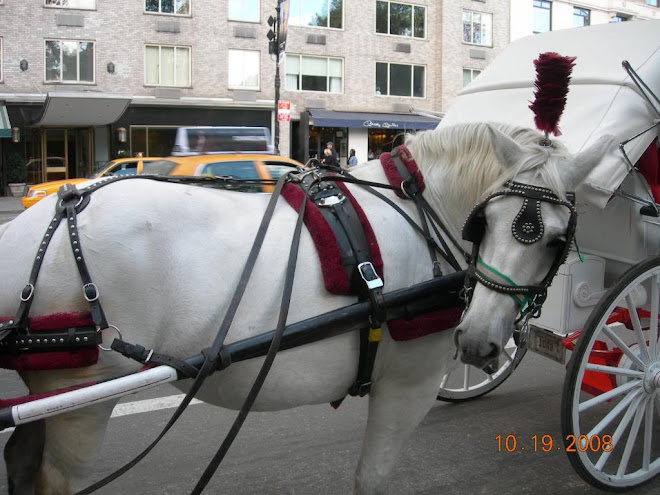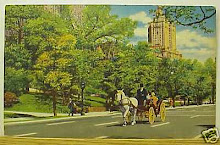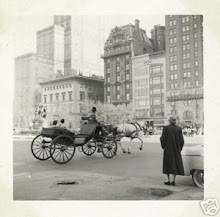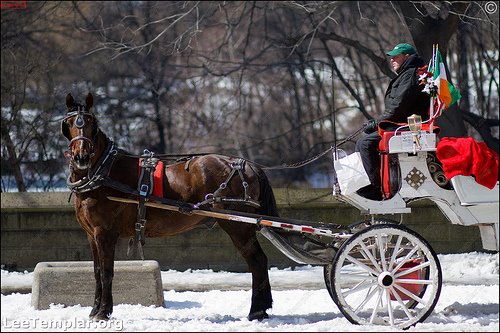Saturday, April 26, 2008
A View From The Box
No, it's not a new Merchant Ivory film lol. The driver's seat on a carriage is commonly called "the box". A carriage driver named Noel Douglas, quoted in a New York Times article many years ago, said of this singular perch: "It's a fine, high seat on the world." And that sums it up beautifully. This time of year it's exceptional; the blossoming cherry trees in the Park, the spring breezes, the extra frisk in your horse as you trot past the brownstones on the Westside on your way to the park. Very, very special.
The whiffle tree as metaphor....
Ah, more whiffle tree talk ~ just what you were hoping for, I'm sure. lol Well, other than it sounding rather whimsical, there is a reason for the name of this blog....
The two main points of contact between the horse and the carriage can be found on either end of the whiffle tree. This is the fulcrum, the point where the kinetic energy that makes a carriage ride possible is transfered from the movement of the horse's massive shoulders, to the collar, along the 'line of draft' through the traces, to the carriage.
So there it is. I'd like this place to be a virtual "whiffle tree"~ a transfer point where the energy from the exchange of ideas, information, and history provides the reader with a delightful and insightful "ride" into the rich and colorful world of NYC's Horse-Drawn Carriages.
Giddup!
The two main points of contact between the horse and the carriage can be found on either end of the whiffle tree. This is the fulcrum, the point where the kinetic energy that makes a carriage ride possible is transfered from the movement of the horse's massive shoulders, to the collar, along the 'line of draft' through the traces, to the carriage.
So there it is. I'd like this place to be a virtual "whiffle tree"~ a transfer point where the energy from the exchange of ideas, information, and history provides the reader with a delightful and insightful "ride" into the rich and colorful world of NYC's Horse-Drawn Carriages.
Giddup!
Friday, April 25, 2008
What is a "whiffle tree"?
For the uninitiated:
whif·fle·tree
n. Northeastern U.S.
Pronunciation: 'hwi-f&l-tree'
The pivoted horizontal crossbar to which the harness traces of a draft animal are attached and which is in turn attached to a vehicle or an implement. Also called singletree, swingletree; also called regionally whippletree.
[Variant of whippletree.]
Regional Note: Whiffletree, a term primarily used in the northeast United States, is derived from the older term whippletree, which is used in the Upper Northern states farther to the west. The fact that whiffletree, the newer term, is used in the Northeast, the older dialect area, illustrates the process of linguistic change. Even as the older word whippletree was spreading westward into a new dialect area, it was evolving into something differentwhiffletreein the area where it originated, as if the older dialect area were somehow trying to keep a step ahead.
Shew! Probably much more than you wanted to know about the etymology, but I like to be comprehensive ;-)
whif·fle·tree
n. Northeastern U.S.
Pronunciation: 'hwi-f&l-tree'
The pivoted horizontal crossbar to which the harness traces of a draft animal are attached and which is in turn attached to a vehicle or an implement. Also called singletree, swingletree; also called regionally whippletree.
[Variant of whippletree.]
Regional Note: Whiffletree, a term primarily used in the northeast United States, is derived from the older term whippletree, which is used in the Upper Northern states farther to the west. The fact that whiffletree, the newer term, is used in the Northeast, the older dialect area, illustrates the process of linguistic change. Even as the older word whippletree was spreading westward into a new dialect area, it was evolving into something differentwhiffletreein the area where it originated, as if the older dialect area were somehow trying to keep a step ahead.
Shew! Probably much more than you wanted to know about the etymology, but I like to be comprehensive ;-)
Subscribe to:
Comments (Atom)












